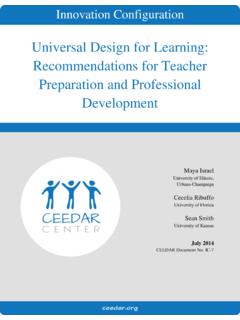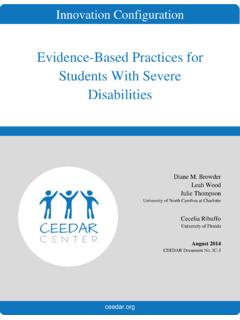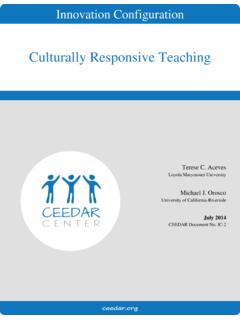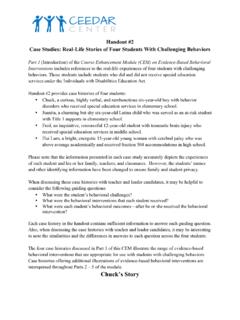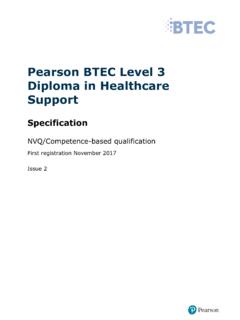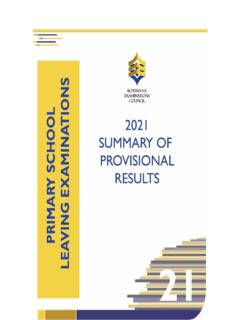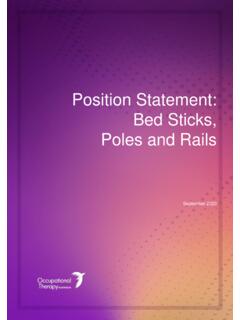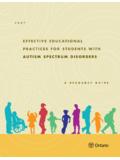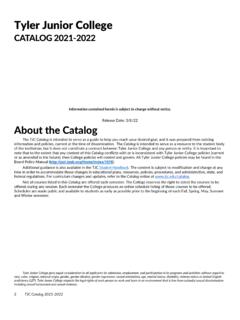Transcription of Evidence-Based Practices for Students With Sensory …
1 Innovation Configuration Evidence-Based Practices for Students with Sensory Impairments Kay Alicyn Ferrell University of Northern Colorado Susan Bruce Boston College John L. Luckner University of Northern Colorado September 2014 CEEDAR Document No. IC-4 Page 2 of 219 Disclaimer: This content was produced under Department of Education, Office of Special Education Programs, Award No. H325A120003. Bonnie Jones and David Guardino serve as the project officers. The views expressed herein do not necessarily represent the positions or polices of the Department of Education. No official endorsement by the Department of Education of any product, commodity, service, or enterprise mentioned in this website is intended or should be inferred. Recommended Citation: Ferrell, K. A., Bruce, S.
2 , & Luckner, J. L. (2014). Evidence-Based Practices for Students with Sensory impairments (Document No. IC-4). Retrieved from University of Florida, Collaboration for Effective Educator, Development, Accountability, and Reform Center website: Note: There are no copyright restrictions on this document; however, please use the proper citation above. Page 3 of 219 Table of Contents List of Tables .. 6 Innovation Configuration for Evidence-Based Practices for Students with Sensory Impairments .. 7 Deaf or Hard of Hearing .. 9 Administration .. 11 Assessment .. 13 assistive technology .. 15 Communication .. 17 Early Identification and Early Intervention .. 18 Life Skills .. 20 Literacy .. 21 Mathematics .. 24 Placement/Inclusion .. 26 Science .. 28 Social-Emotional/Behavior .. 29 Transition .. 31 Conclusion.
3 33 Visual Impairment .. 35 Administration .. 37 Assessment .. 40 assistive technology .. 43 Communication .. 45 Page 4 of 219 Early Identification and Early Intervention .. 46 Life Skills .. 49 Literacy .. 53 Mathematics .. 56 Placement/Inclusion .. 59 Science .. 60 Social-Emotional/Behavior .. 60 Transition .. 61 Conclusion .. 63 Deafblindness .. 64 Administration .. 65 Assessment .. 66 assistive technology .. 67 Communication .. 69 Early Identification and Early Intervention .. 71 Life Skills .. 73 Literacy .. 76 Mathematics .. 78 Placement/Inclusion .. 79 Science .. 81 Social-Emotional/Behavior .. 82 Transition .. 84 Conclusion .. 84 Page 5 of 219 References .. 86 Appendix: Innovation Configuration for Evidence-Based Practices for Students with Sensory Impairments .. 161 Page 6 of 219 List of Tables Table 1: Comparison of Students with Visual Impairments Who Participated in SEELS.
4 36 Page 7 of 219 Innovation Configuration for Evidence-Based Practices for Students with Sensory Impairments This paper features an innovation configuration (IC) matrix that can guide teacher preparation professionals in the development of appropriate content for Evidence-Based Practices (EBPs) for Students with Sensory impairments. This matrix appears in the Appendix. An IC is a tool that identifies and describes the major components of a practice or innovation. with the implementation of any innovation comes a continuum of configurations of implementation from non-use to the ideal. ICs are organized around two dimensions: essential components and degree of implementation (Hall & Hord, 1987; Roy & Hord, 2004). Essential components of the IC along with descriptors and examples to guide application of the criteria to course work, standards, and classroom Practices are listed in the rows of the far left column of the matrix.
5 Several levels of implementation are defined in the top row of the matrix. For example, no mention of the essential component is the lowest level of implementation and would receive a score of zero. Increasing levels of implementation receive progressively higher scores. ICs have been used in the development and implementation of educational innovations for at least 30 years (Hall & Hord, 2001; Hall, Loucks, Rutherford, & Newton, 1975; Hord, Rutherford, Huling-Austin, & Hall, 1987; Roy & Hord, 2004). Experts studying educational change in a national research center originally developed these tools, which are used for professional development (PD) in the Concerns- based Adoption Model (CBAM). The tools have also been used for program evaluation (Hall & Hord, 2001; Roy & Hord, 2004). Use of this tool to evaluate course syllabi can help teacher preparation leaders ensure that they emphasize proactive, preventative approaches instead of exclusive reliance on behavior reduction strategies.
6 The IC included in the Appendix of this paper is designed for teacher preparation programs, although it can be modified as an observation tool for PD purposes. The Collaboration for Effective Educator, Development, Accountability, and Reform (CEEDAR) Center ICs are extensions of the seven ICs originally created by the National Comprehensive Center for Teacher Quality (NCCTQ). NCCTQ professionals wrote the above description. Page 8 of 219 Hearing loss, visual impairment, or a combination of hearing loss and visual impairment of any type or degree potentially interferes with typical methods of interacting and learning. In 2011, Students with Sensory impairments comprised less than 2% of all children and youth with disabilities and of the entire school-age population ( Department of Education, National Center on Education Statistics [NCES], 2012).
7 This small percentage reminds us that some school districts will never enroll a child with a Sensory impairment of any type, and some teachers even special educators will never instruct a student with one of these disabilities. The low-prevalence nature of Sensory impairments ( , consistently small numbers of children and youth across the United States in proportions that have remained relatively steady for more than 50 years) has resulted in misunderstandings, low expectations, and a lack of knowledge about EBPs simply because education personnel have lacked familiarity with how these Students learn. The test of any intervention or procedure is evidence not whatever works but what works. There may be more information about the effectiveness of various consumer products than the methods we use to teach children and youth with Sensory impairments.
8 For many reasons, educational research on Students with Sensory impairments is difficult to conduct. The population is geographically dispersed, making it difficult without considerable expense to identify an adequate group of study participants. Participants who are identified are often extremely heterogeneous and exhibit a range of diagnoses, functioning levels, and additional disabilities. Specialized schools, once the greatest source of research samples, no longer offer homogeneous populations and special curricula. In 2006, about 80% of Students with Sensory impairments attended general education classes in public schools for at least some of the school day ( Department of Education, Office of Special Education Programs [OSEP], 2011, p. 59). Manipulation of variables in a controlled study, such as a reduction of services or alternate types of Page 9 of 219 services, often interferes with meeting legislative mandates.
9 Simultaneously, school districts have been reluctant to consent to research because it takes away from other instruction. For this collection of essential components, we have reviewed the research literature in our respective fields for high-quality research that meets the Collaboration for Effective Educator, Development, Accountability, and Reform (CEEDAR) Center evidence standards (see ). Although there was strong research- based evidence of effective Practices in some areas, the literature was often characterized by emerging Practices and limited evidence . When no research was found on a specific aspect of a topic, we turned to legislation, policy documents, and textbooks to complete our analyses. We arranged this narrative first by the disability categories of deaf or hard of hearing, visual impairment, and deafblind.
10 Then, within each disability category, we addressed 12 topical areas critical to an analysis of EBPs in today s educational system for Students with Sensory impairments. Deaf or Hard of Hearing The term hearing impairment has often been used as legislative terminology to refer to the primary disability category for Students who receive Individuals with Disabilities Education Act (IDEA, 2004) services through an individualized education program (IEP) for hearing loss. However, professionals in the field and individuals with hearing loss have preferred to use the terms deaf or hard of hearing. It is important to recognize that the population of Students who are deaf or hard of hearing has been found to differ from the general student population as well as from other Students with Page 10 of 219 disabilities who receive IDEA services.
